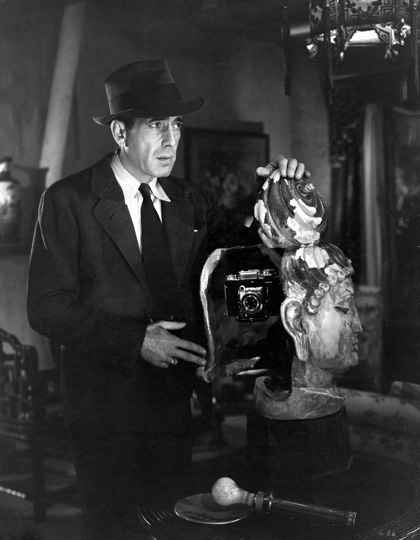Review / From the archives
The Big Sleep

Howard Hawks’ 1946 adaptation of Raymond Chandler’s famously Byzantine first Philip Marlowe novel is a tantalising brew of apparent suspense, vivacious women and entertaining bits of business, says John Pym – who also diligently unravelled the plot in this 1978 review for the Monthly Film Bulletin
The Big Sleep
USA 1946
Director: Howard Hawks
With Humphrey Bogart, Lauren Bacall, Martha Vickers, John Ridgely, Charles Waldron, Dorothy Malone, Elisha Cook Jnr., Sonia Darrin
114 mins | Cert PG
Synopsis
Our synopses give away the plot in full, including surprise twists.
Los Angeles, the 1930s. Private detective Philip Marlowe is retained by General Sternwood, a crippled oil millionaire, who is being prevailed upon for money by Arthur Gwynn Geiger, a disreputable bookstore owner. That night, Marlowe happens upon Geiger’s corpse and the General’s drugged daughter Carmen in the living-room of Geiger’s house. Marlowe discreetly removes Carmen, and next day is taken by his friend Bernie Ohls of the DA’s department to watch the body of the Sternwood chauffeur, Owen Taylor, being retrieved from the ocean. It later transpires that Taylor shot Geiger and fled with some compromising photographs of his former lover Carmen. Taylor was subsequently knocked out by one Joe Brody who then attempted to use the photographs to blackmail Carmen’s older sister, divorcée Vivian Rutledge. Brody, however, is shot dead by Carol Lundgren, Geiger’s boyfriend, who is under the misapprehension that it was Brody who killed Geiger. Marlowe manages to catch Lundgren and delivers him to the police.
His commission apparently fulfilled, Marlowe is nevertheless still curious about Sean Regan, an employee of the Sternwoods who is said to have disappeared with Mona, the wife of club-owner Eddie Mars. Marlowe finally obtains a lead on Mona’s whereabouts from Agnes Lozelle, Geiger’s employee, Brody’s former consort and now the girl of inoffensive Harry Jones, who is poisoned by Mars’ hitman Canino before he can give Marlowe the information himself. Later, Marlowe finds Mona, kills Canino and using himself as bait lures Mars to Geiger’s house: it is revealed that Mars killed Regan and convinced Vivian that Carmen was an accomplice; Vivian has been shielding Carmen for the sake of their ailing father. Marlowe forces Mars to leave the house and he is shot dead by gunmen waiting for Marlowe. Vivian and Marlowe, who appear to be in love, await the arrival of the police.
Review
One of the most gratifying reflections on the virtually impenetrable web of duplicity and murder that constitutes the plot of The Big Sleep is that, from Hawks’ point of view, it really doesn’t matter who killed Owen Taylor. What does matter – and this despite the superb, spare evocation of desolation, rainy nights and an all-pervasive sense of genuine evil – is the illusion of suspense that the film so brilliantly sustains. However many times one sees the film and comes away baffled by exactly who did what to whom, it still regularly leaves one with the exhilarating feeling that perhaps next time all will indeed be satisfactorily resolved. (Notwithstanding the scriptwriters’ famous bafflement over the fate of Owen Taylor, the plot, which is clearly divided in two, can in fact be explained in a logical, if ultimately rather tortured fashion.)
The film’s strength, as Hawks himself observed, derived in large part form a structure of self-contained, set-piece episodes, almost all of which are memorable for a different reason: the jungle meeting between Marlowe and General Sternwood; the sustained ’horse-racing’ conversation between Marlowe and Vivian at Mars’ club; the poisoning of Harry Jones seen through frosted glass; the confusion, worthy almost of the Marx Brothers, when more and more guns are produced at Joe Brody’s apartment.

Quite outside the plot itself, the film turns on the way Hawks juxtaposes his male and female characters. There are a superabundance of vivacious women: the librarian; the cigarette girl and the waitress at Mars’ club; Agnes; Mona; Carmen (despite her instability) and, of course, Vivian Rutledge herself. The Hawksian women – tough, individual, opinionated – are all doers; in contrast, with the exception of Eddie Mars, the seedy gallery of male crooks are on the whole so entangled in the webs of their own intrigues and ambitions that they can only react to events.
Although it was not seen as such by many of its early reviewers, The Big Sleep is also, of course, a witty, literate entertainment and one that has endured in the popular imagination not only for the famous Bogart-Bacall exchanges (loaded as they were in 1946 – and indeed as they remain today – with a delicious, explicitly, sexual charge), but also in a film that has ironically very little to do with the spirit of Chandler’s rather moralistic first novel, for the carefully placed Chandlerisms, the apposite, self-protective wisecracks and the tart summaries of character (“I assume”, Sternwood remarks of his daughters, “they have all the usual vices”). The plethora of killings now seems on the whole less horrific than it once did, while the film’s tone of escalating absurdity in a genuinely dark world grows if anything even more sprightly as the years go by.
John Pym, Monthly Film Bulletin, October 1978
See also
Giant steps: David Thomson on Night Moves and the uncompromising films of the 1970s New Hollywood (September 2006)
The big stealer: Nick James on Robert Mitchum’s ultimate doomed film noir heroes (August 2005)
